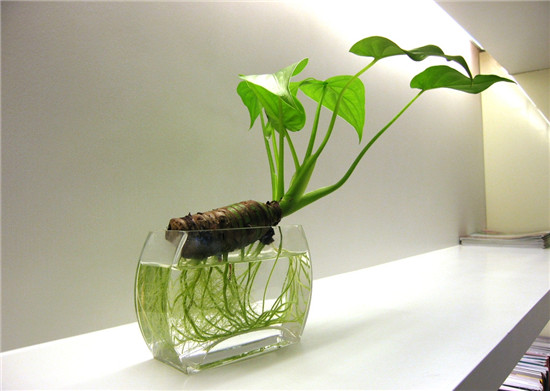Dishui Guanyin cultivation method Dishui Guanyin cultivation points
Dishui Guanyin is also known as Dishui lotus, bergamot lotus, and has medicinal value. next, let's take a look at the Dishui Guanyin culture method and the main points of Dishui Guanyin culture.

Dripping Guanyin, Araceae, Amorphophallus, also known as Dichondra, bergamot, etc., perennial evergreen herbs with medicinal value; under warm and humid conditions, water drips down from the tip or edge of the leaf; and the flowers are like Guanyin, so it is called dripping Guanyin.
Dishui Guanyin is a perennial erect herb with 2m plants, fleshy rhizome, long petiole, broad leaf sheath, large leaves, shield-shaped arrow-shaped, aggregated stem tip, tip, edge microwave, main vein obvious. Buddha flame bracts yellowish green, fleshy inflorescences.
Reproduction of Dishui Guanyin
(1) sowing: wild plants often bear seeds and sow in spring. The suitable temperature for germination is 25-28 ℃ and germinates 20-25 days after sowing.
(2) insertion: it will be carried out in April. Cut the sturdy stem, which grows about 10 cm, and use the stem segment with several bud eyes as cuttings, slightly dry and then obliquely insert or lie flat on the seedbed, with the depth of the stem segment buried; the cuttings can also be directly planted in the basin. Keeping the substrate moist and ambient temperature 25-2TC after insertion, it can take root and survive after 4-5 weeks.
(3) ramet: the potted plant is easy to produce many small plants in the base, which can be divided in April, and the small plant and the mother plant can be separated and planted respectively. Ramet should be carried out when the temperature reaches 20C or higher, and new buds can be produced in about 20 days on the basis of keeping the substrate moist.

The Culture method of Dishui Guanyin
1. Temperature: like warmth, grow rapidly when it is over 25 ℃, and the most suitable temperature for growth is 25-30C. It has a certain ability to resist cold, and the overwintering temperature can be maintained above 2 ℃.
2. Light: like semi-overcast, can not bear the exposure of strong sunlight. From May to September, shade should be provided to cover about 50% of the sun. The rest of the time should be given plenty of sunshine. Do not tolerate excessive shading, otherwise the petiole becomes thinner and longer, not only the plant shape is not beautiful, but also easy to break.
3. Watering: because the leaves are huge and consume a lot of water, they are afraid of drought. Like the slightly wet soil environment, during the growth period of watering to master "dry and wet and wet", watering should be adequate, even if it is watered more. Especially in the hot summer, we should pay more attention to the supply of water to meet the water requirements of the plant.
4, environmental humidity: like the humid environment, avoid dry air, the growing season is sunny and dry, should often spray water to the branches and leaves and around, in order to maintain high air relative humidity.

5. Fertilization; like to be fertilized. Due to the large growth, it is necessary to supplement nutrients in time in order to make the stem grow stout, the leaves are large and bright green, and the leaves are small and yellow when lack of fertilizer. Nitrogen-based fertilizer should be applied every 10 days during the growth period. People stop applying nitrogen fertilizer after autumn and topdressing 2-30: phosphorus and potassium fertilizer. Stop fertilizing in winter.
6. Pruning: yellow leaves should be cut off at any time. Because the petiole is long, it is necessary to avoid breaking the petiole when moving, placing and maintaining. If it is injured, it should be cut off in time.
7. Turn the basin: turn the basin once every 1-2 years. The requirement for soil is not high, but it likes the sandy loam with fertile, loose and good drainage, and the matrix can be prepared with rotten leaf soil, garden soil, peat soil, river sand and other materials. If sufficient basal fertilizer is applied, the leaves can be enlarged. Due to the large number of leaves and small number, long petiole, moving plants and maintenance, should avoid damage to the leaves, otherwise it will reduce the ornamental value.

The above is the whole content of the Dishui Guanyin breeding method and the main points of Dishui Guanyin culture. I hope this article can help you. Please continue to follow us.
Related
- Wuhan Hospital Iron Tree Blooming Result Was Instantly Frightened by the Gardener Master
- Which variety of camellia is the most fragrant and best? Which one do you like best?
- What is the small blue coat, the breeding methods and matters needing attention of the succulent plant
- Dormancy time and maintenance management of succulent plants during dormancy
- Minas succulent how to raise, Minas succulent plant pictures
- What are the varieties of winter succulent plants
- How to raise succulent plants in twelve rolls? let's take a look at some experience of breeding twelve rolls.
- Attention should be paid to water control for succulent plants during dormant period (winter and summer)
- Watering experience of twelve rolls of succulent plants
- Techniques for fertilizing succulent plants. An article will let you know how to fertilize succulent plants.



